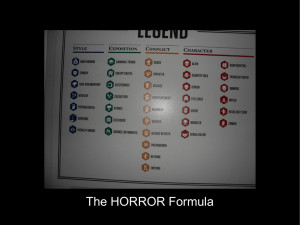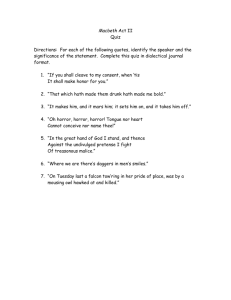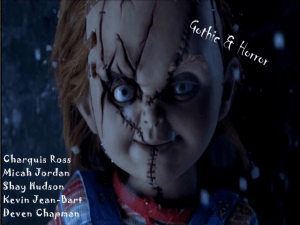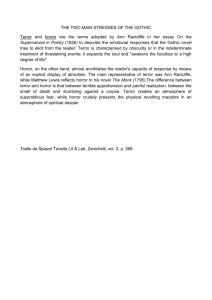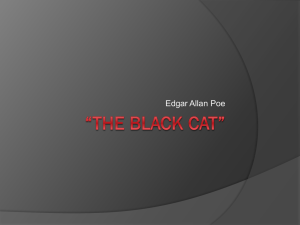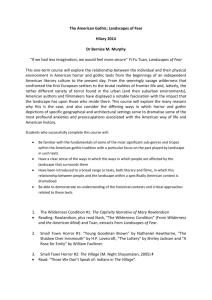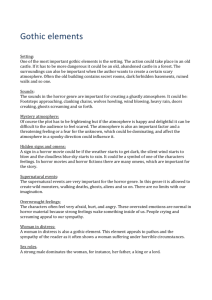Mysterious Fears and Ghastly Longings
advertisement
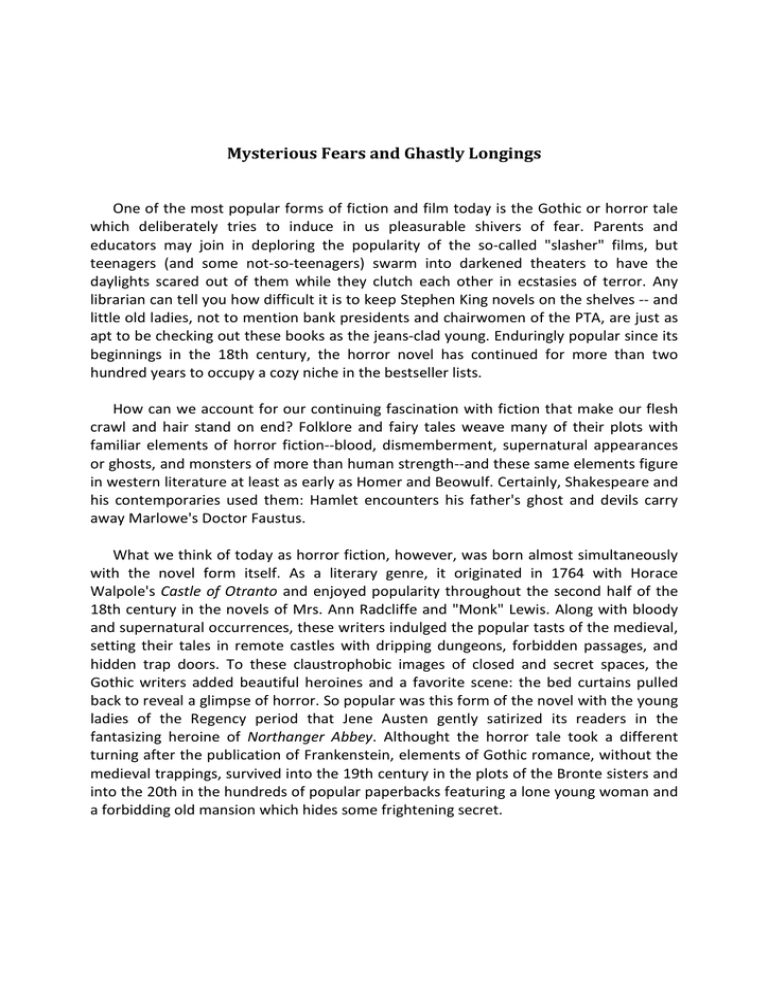
Mysterious Fears and Ghastly Longings One of the most popular forms of fiction and film today is the Gothic or horror tale which deliberately tries to induce in us pleasurable shivers of fear. Parents and educators may join in deploring the popularity of the so-called "slasher" films, but teenagers (and some not-so-teenagers) swarm into darkened theaters to have the daylights scared out of them while they clutch each other in ecstasies of terror. Any librarian can tell you how difficult it is to keep Stephen King novels on the shelves -- and little old ladies, not to mention bank presidents and chairwomen of the PTA, are just as apt to be checking out these books as the jeans-clad young. Enduringly popular since its beginnings in the 18th century, the horror novel has continued for more than two hundred years to occupy a cozy niche in the bestseller lists. How can we account for our continuing fascination with fiction that make our flesh crawl and hair stand on end? Folklore and fairy tales weave many of their plots with familiar elements of horror fiction--blood, dismemberment, supernatural appearances or ghosts, and monsters of more than human strength--and these same elements figure in western literature at least as early as Homer and Beowulf. Certainly, Shakespeare and his contemporaries used them: Hamlet encounters his father's ghost and devils carry away Marlowe's Doctor Faustus. What we think of today as horror fiction, however, was born almost simultaneously with the novel form itself. As a literary genre, it originated in 1764 with Horace Walpole's Castle of Otranto and enjoyed popularity throughout the second half of the 18th century in the novels of Mrs. Ann Radcliffe and "Monk" Lewis. Along with bloody and supernatural occurrences, these writers indulged the popular tasts of the medieval, setting their tales in remote castles with dripping dungeons, forbidden passages, and hidden trap doors. To these claustrophobic images of closed and secret spaces, the Gothic writers added beautiful heroines and a favorite scene: the bed curtains pulled back to reveal a glimpse of horror. So popular was this form of the novel with the young ladies of the Regency period that Jene Austen gently satirized its readers in the fantasizing heroine of Northanger Abbey. Althought the horror tale took a different turning after the publication of Frankenstein, elements of Gothic romance, without the medieval trappings, survived into the 19th century in the plots of the Bronte sisters and into the 20th in the hundreds of popular paperbacks featuring a lone young woman and a forbidding old mansion which hides some frightening secret. Writers and readers of horror or Gothic fiction were part of the movement away from the classical order and rationality of the 18th century Enlightenment and toward the cultivation of feeling and imagination which we label the Romantic movement. However, they are also part of that worship of science and scientific record which characterized the Victorians. All three of the great horror novels of the 19th century (whose characters--Frankenstein and his monster, Dr. Jekyll and Mr. Hyde, and Dracula-have endured to pass from literature into folk myth in our own time) use the narrative technique of "real" documentation: letters, journals, newspaper articles, even a phonograph record. Although the epistolary form was a common convention of the period, these writers seem bent on emphasizing as "simple fact" the horrible events and racking emotions they describe. Many critics have tried to define the horror experience. Mrs. Radcliffe, the "jounding mother" of the horror novel, distinguished between the effects of horror and terror: "terror expands the soul and wakes the faculties. Horror freezes, contracts, nearly annihilates them." Terror consists not of sensations, but of awful apprehensions, what one critic has called "theological uncertainty" and another has called "the smell of death." Horror, on the other hand, stumbles over the corpse; it is sickening realization. Stephen King admits his own practice: "I recognize terror as the finest emotion… and so I will try to terrorize the reader. But if I find that I cannot terrify him/her, I will try to horrify. And if I find that I cannot horrify, I'll go for the gross-out. I'm not proud." The "gross out" touches what King calls "phobic pressure points" to make us relive childhood fears: fear of the dar, of rats, spiders, and big dogs, of heights which activate our fears of falling and, conversely, of that shut-in-the-closet feeling. Freud claimed that horror (his term was the "Uncanny") is our response to the old and familiar made strang eby repression. Our own imaginings return to us in a distorted disguise. A modern psycho-analytically oriented critic, Julia Kristeva says, however, that horror deals with forbidden or painful material just on the edge of repression, but not entirely repressed. This forbidden material consists of fears and desires which would make us feel guilty or ashamed if we allowed them into our conscious minds. And no one of us is free of them. We are all surrounded from birth by forms of sexuality and possible sexual partners, many of which are forbidden. Moreover, we are subjected from birth to the civilizing process which tries to suppress our natural propensity for violence, the violence which we can observe in any unsupervised group of two year olds bashing and biting each other. Horror fiction, like other forms of popular culture, enables its readers to enjoy in safety their own taboo fantasies of violence and secuality, their own "ghastly longings" and "mysterious fears." Is this about-to-be-repressed material which paralyzes us with horror the same for the writer of Beowulf and the writer of Frankenstein? Certainly much of what horrifies us has been the same throughout the years: fantasies of cannibalism, of dismemberment, of violent murder, and if incest have probably been shoved into the hiding place of the human unconscious since men began to walk erect, certainly since they began to live together as social beings. However, Nancy Shulin, writing in The Norman Transcript in 1991, asserts that our choosing to experience horror tends to be cyclical, flourishing in moments of acute anxiety. Other critics of horror fiction claim, moreover, that our view of what is horrible is conditioned strongly by events of social and cultural history, that horror is not a literary genre, but a cultural response. This series of paired novels with similar themes and plots offers opportunities to evaluate this latter view, exploring not only the sameness of human psychology through time, but the differences between the responses to cultural stimuli shaping the horror experience in the 19th and 20th centuries. Dr. Jekyll and Mr. Hyde by Robert Louis Stevenson The Dark Half by Stephen King Dr. Jekyll and Mr. Hyde launched Robert Louis Stevenson's career as a novelist about a decade before the Interpretation of Dreams launched the career of Sigmund Freud, who changed forever our concept of the self. Freud showed us that we could no longer see ourselves as totally conscious rational beings. We had to accept ourselves as divided beings, often driven by dark, unconscious forces that showed themselves only in our dreams. A hundred years later, Stephen King is still able to frighten us in The Dark Half with the concept of an unconscious self, a capacity for evil lurking below the surface of our ordinary workaday selves. Although in both novels evil takes the form of the capacity for violence lying beneath the surface of our respectable selves, that capacity differs in the two books. Stevenson gives us only two violent incidents and very little blood. Hyde knocks down and tramples a child, whose injuries, though shocking, are apparently not fatal; he also bludgeons to death an old man in a fit of temper, but we are told of his crime in the past tense. Stevenson's one corpse is quite cold and decently laid out before we are made aware of it. King's dark self, on the contrary, not only swings a straight razor and creates an ocean of blood, but the reader is very much on the scene of his multiple murders. We stumble over his corpses. The major difference, however, in the violence of the two novels is that Stevenson's Hyde is overcome by fits of passion; his crimes result from imperfect self-control rather than deliberate malice. Evil as Hyde is, he still shares some of Jekyll's humanity. King's George, on the other hand, seems to have no passion to control. His crimes are committed with deliberate rationality, cleverness, and cold inhumanity. The 19th century pinned its faith in science. Freud tried to describe the mysteries of the human psyche scientifically and hoped for eventual scientific mastery of them. Stevenson, his near contemporary, employed not-yet-discovered techniques of medical science, "the powder," to achieve the metamorphosis of the good Dr. Jekyll into the evil Mr. Hyde. This is nothing occult about Jekyll's experiments even though all the characters agree that Hyde "seems hardly human," and Lanyon condemns his old friend Jekyll for being "too fanciful." Stephen King's 20th century horror tale, on the other hand,, though it begins with medical technology--a neurosurgeon excising an undeveloped twin from the hero's brain--is unashamedly supernatural in its plot development. After all, now that medical science has indeed discovered drugs which can control schizophrenia, horror has less room to grow. The 20th century turns instead to the occult for its shivers of horror: imaginary bodies claw their way out of real graves and sparrows ferry a decaying body back to another world. Today, perhaps, we sense fewer restraints on the appetites that make us Hydes. We see Hyde on the evening news, rather than prowling the urban shadows. We need somehow to feel that such evil is not of our world, but of another. Frankenstein by Mary Shelley Mutation by Robin Cook Although published more than 170 years apart. Mary Shelley's Frankenstein and Robin Cook's Mutation share both the names of the heroes and a common theme: our "ghastly longing" for the knowledge which is power. This longing for knowledge is the original sin of mankind narrated in Genesis. In the 19th century, the quest for suck knowledge was called "natural philosophy"; today we call it science. Both books celebrate man's growing mastery of scientific technology, but--more importantly--both explore our fear of our own potential creations. In the early 19th century, the idea that electricity or "galvanism" might prove the means of giving life to the inanimate was both fascinating and frightening, and Frankenstein exploits this fear and fascination. Mutation plays on more modern anxieties. In the 20th century, the organic secrets of in vitro fertilization, surrogate motherhood, and all the alterations in living cells which we call genetic engineering are beginning to replace our fear of the hydrogen bomb as our deepest nightmare. Despite their common theme, the differences between the two books are overwhelming. The creations, VJ and the monster, are almost reverse images of each other: The monster is hideous, while VJ is handsome; the monster is educated by reading Paradise Lost, VJ by reading the Journal of Cellular Biology. Yet Cook uses one of the most common trappings of the Gothic novel which Frankenstein lacks: the closed and secret space in the midst of the familiar, VJ's hidden laboratory with its camouflaged trap door. Mary Shelley, on the other hand, chases her monster through vast spaces as far as possible from the domestic. However, she employs another familiar Gothic scene: the bedside when the curtains are pulled back and horror glimpsed. Frankenstein rouses from sleep to find his horrible monster staring down at him. Most importantly, the two creations--VJ and the nameless monster--evoke very different responses. The monster is man as Rousseau proclaimed him: naturally good, but made vicious by misery and deprivation. We feel sorry for him and can uneasily identify with his desperate need for love and fellowship. VJ, on the contrary, personifies innate natural depravity. He is amoral by nature--all brain and no heart. Far from seeking love or friendship, he rejects it or manipulates it for his own purposes. He kills without remorse and creates without responsibility. Worst of all, VJ's ethic is horrifyingly familiar to us: total objectivity, the end justifying the means. At least Frankenstein and his monster had the grace to know their guilt and to suffer. Dracula by Bram Stoker 'Salem's Lot by Stephen King Bram Stoker's Dracula evidently appeals to something fundamental in the human psyche because it has never been out of print since its publication in 1897. It exists today in seventeen editions from seventeen different publisher, not to mention its many adaptations for film and the theater. The vampire is most clearly associated with forbidden sexuality, portraying--as one scholar puts it--"sadistic erotomania at its intensent." In English literature, the vampire has been a sexual predator since Polidori's novella The Vanpyre was published in 1819. Stoker's Dracula drips with sex, disguised though it is as blood-sucking and impalement. The writhings and screams of Lucy Westenra, when the men try to save her soul by driving a stake through her Undead heart, resemble the transports of a passionate woman in the throes of orgasm. Perhaps the only way a stalwart Victorian male could confront female passion was to confine the woman to a coffin, cut off her head, and stuff her mouth with garlic. Stephen King, however, "jettisoned the sex angle" in 'Salem's Lot. Why not? In the 20th century, sex in all its varieties has come out of the closet and can no longer provide fertile ground to nourish the horror experience. In Dracula, the vampire encounters are personal, one on one, accompanied by intense emotion. In King's novel, the vampires operate in a mostly impersonal, wholesale fashion. The horror derives not so much from the personal encounter, the loss of individual souls, as from the sheer numbers as well as the rapidity of the disappearances. Although King's image of the Deserted Village is a literary phenomenon as old as the birth of the industrial revolution, the theme of disappearance, just vanishing in the night, is probably a peculiarly 20th century horror. Although epidemics bringing wholesale death were much more frequent in the 10th century, and losing a wife, parent, or child to death was not an uncommon experience, in our century we have undergone the Holocaust in Germany, when Jews vanished after the terrifying knock at the door, as well as los desparecidos--the "disappeared ones"--in Latin America. We eat our breakfast cereal facing on our milk cartons the pictures of "missing" children. Moreover, widespread divorce in our highly mobile society means that wives, husbands, mothers, and fathers often simply fade out of our lives without the time to mourn their loss that death would have provided. They become the Undead to haunt us. Northanger Abbey by Jane Austen Mistress of Mellyn by Victoria Holt In its evolution, the Gothic romance or "sentimental-Gothic" pioneered by Mrs. Radcliffe in The Mysteries of Udolpho (1794) has become identified with women's fiction. Since the 18th century, women have made up the majority of the readers of romances and have often constituted the majority of the writers of romances, as well. In the 18th and 19th centuries, the common plot of romance novels--while colored by supernatural occurrences and sinister appearances--involved the heroine-victim's overcoming of obstacles to achieve her true love, marriage, and economic stability. In the 18th and 19th centuries, when "career options" did not exist for women, these plots reflected social and economic realities. In the 20 century, even after women's suffrage and women's liberation, the plots haven't changed much. And since the publication of Mistress of Mellyn in 1960, the publication and popularity of Gothic romances have risen steadily. Perhaps the "mysterious fear" of 20th century woman is that she will remain single? Neither Jane Austen's Northanger Abbey nor Victoria Holt's Mistress of Mellyn precisely fits the definition of the Gothic novel or the romance novel, although both contain elements of each genre. Austen's novel accurately reflects the historical period during which it was written (1803) and satirizes not only the reading habits of women but also the society that forces women to practice all sorts of gypocrisy in order to achieve a husband. Holt's novel seems to take place in some historical Never Land (somewhere in the 19th century?) and takes itself very seriously. In Catherine Morland, Austen creates a kind of anti-heroine for romance--she is neither ravishingly beautiful nor startlingly intelligent--but she is primed for the adventures of a heroine by her reading of Gothic novels. Martha Leigh, on the other hand, is intelligent enough to be a governess (one of "two courses open to a gentlewoman when she finds herself in penurious circumstances") and beautiful enough given the right dress and circumstances. Catherine is openly aiming for the second course available to gentlewomen--marriage-- while Martha arrives at it through her innate (but unconscious) superiority to her rivals. Both heroines expect to encounter adventure in ancient dwellings--Northanger Abbey and Mount Mellyn-- and wonder about forbidden rooms and secret passageways. Both suspect their hosts of murder, and both are wrong in their suspicions, although Catherine is probably right to suspect the character of General Tilney, while Connan TreMellyn's transformation from villain to husband is typical of romance novels. Anyone who enjoyed Jane Eyre will find similar satisfaction in Mistress of Mellyn. And there are many more similar novels by Victoria Holt (and Phillippa Carr and Jean Plaidy, other pen names of Eleanor Burford Hibbert). Northanger Abbey, on the other hand, is a unique pleasure. More About Gothic and Horror Fiction: Aguirre, Manuel. The Closed Space: Horror Literature and Western Symbolism. New York: Manchester, 1990. Barclay, Glen St. John. Anatomy of Horror: The Masters of Occult Fiction. London: Wedenfeld and Nicolson, 1978. Hennesey, Brendan. The Gothic Novel. London: Longman's, 1978. King, Stephen. Danse Macabre. New York: Everest, 1981. McConnell, Frank. The Spoken Seen. Baltimore: Johns Hopkins, 1975. McNally, Raymond and Radu Florescu. In Search of Dracula: A True History of Dracula and Vampire Legends, New York: Galahad, 1972. Mussell, Kay. Women's Gothic and Romantic Fiction: A Reference Guide. Westport, CT: Greenwood, 1981. Praz, Mario. Three Gothic Novels. London: Penguin, 1978. Punter, David. The Literature of Terror: A History of Gothic Fictions from 1765 to the Present Day. London: Longman's, 1980. Sage, Victor. Horror Fiction in the Protestant Tradition. New York: St. Martin's, 1988. St. Armand, Barton L. The Roots of Horror in the Fiction of H.P. Lovecraft. Elizabethtown, New York: Dragon, 1977. Summers, Montague. The Vampire. New York: Dorsett, 1991. Twitchell, James B. The Living Dead: A Study of the Vampire in Romantic Literature. Durham, NC: Duke, 1981. Virginia Perschbacher of the Chickasaw Library System and scholar Carol Saylor of Ardmore came up with the idea for "Mysterious Fears and Ghastly Longings." Perschbacher helped with the selection of books based on her first-hand knowledge of library patrons' interests. Saylor developed the theme materials, with help from Jennifer Kidney. "Mysterious Fears and Ghastly Longings" was funded by a grant to the Chickasaw Library System and the National Endowment for the Humanities. a project of the
